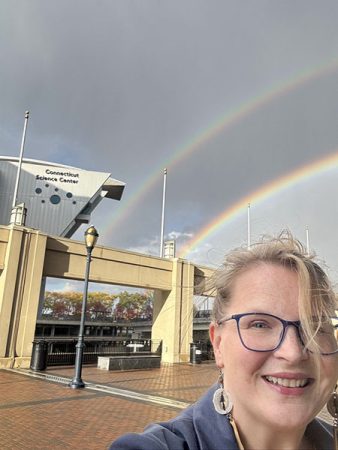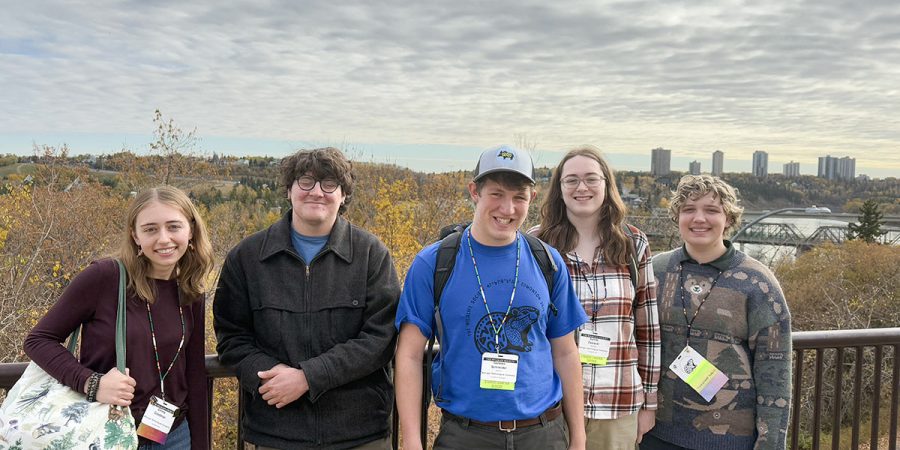
The College of Forest Resources and Environmental Science was well-represented at two national conferences this fall—the Society of American Foresters National Convention and The Wildlife Society’s Annual Conference.
SAF Vice President Leads Huskies at National Convention
Tara Bal, CFRES associate professor of forest health, helped lead the Husky pack at the Society of American Foresters (SAF) National Convention in Hartford, Connecticut, where she spoke as the national organization’s vice President. When her VP term ends, she’ll be inducted as SAF’s president. Bal said being elected to SAF leadership has given her a broader view of how the nation’s foresters are adapting to a rapidly changing field.
“Our field is expanding beyond traditional management to include more technology, climate resilience, and stronger community engagement,” said Bal. “What’s inspiring is seeing SAF embrace this shift—helping redefine what it means to be a forester today: a connector of science and society, and a leader in sustainable, inclusive land stewardship.”

As forestry moves into an exciting new stage, Bal and Tech’s SAF chapter—also known as the MTU Forestry Club—took advantage of the opportunity to connect with and learn from forestry experts. Bal, who’s attended more than 10 SAF national conferences and about 50 state chapter conferences throughout her career, can testify to their value for young forestry professionals. The national convention included technical sessions, workshops, and chances to seek education and career opportunities while building professional relationships.
“It reinforces that they’re part of something bigger—a national (and even international) community dedicated to sustainable and healthy forests and natural resources,” said Bal. “I wouldn’t be at Michigan Tech today if I didn’t pick up a Michigan Tech brochure and talk to the person behind the booth at my first SAF convention.”
CFRES Dean David Flaspohler, Outreach Coordinator Sierra Williams, forest science graduate student Tom Panella, and four Forestry Club members also represented the College at the convention. Data science graduate student Yaman Aljnadi ’26 attended as a guest. They went to mixers with other young professionals, learned about slash walls and watershed protection, and toured the highland forests of Connecticut. Their team also made it to the second round of the SAF’s quiz bowl. With so much to explore, network, and learn, each Husky had their own takeaways from the event.
Tristan Walk, a forestry major graduating in 2026 and the Forestry Club’s current president, took time to network with his fellow young professionals who will soon be entering the field.
“The opportunity to meet dozens of other schools and their students was something I was really looking forward to,” said Walk. “Shaking hands, laughing, and connecting with so many students was eye-opening to just how diverse and passionate our generation of foresters will be.”
Marah Putnam, the club’s media and merchandising officer, who is graduating with her forestry degree in 2028, took the time to build her knowledge base, attending sessions and panels led by industry experts.
“Hearing professionals discuss topics like sustainable harvesting, wildlife habitat conservation, and the role of forests in carbon sequestration helped me see how interconnected ecology, policy, and technology are in shaping the future of our forests,” said Putnam.
Maddie Allen, a forestry major graduating this December in the 2025 mid-year commencement and treasurer for the Wildland Fire Club, gained perspective on the history of SAF and forestry professions as a whole.
“I get to be a part of a profession that is not only time-honored, but growing and changing as the years go by,” said Allen. “Getting to see where SAF came from 125 years ago is incredible and is something I will always think about when I’m in the woods. From the lowly Biltmore stick to the most high-tech drone, everyone is doing it for the same thing: trees.”
Wildlife Students Attend Society’s Annual Conference
CFRES was represented at The Wildlife Society’s Annual Conference in Edmonton, Alberta, by Flaspohler, Williams, graduate forest science student and current Wildlife Society board member for the early career professional working group Courtney King ’29, and five members of Tech’s Wildlife Society chapter. The conference is one of the largest gatherings of wildlife ecology, management, and conservation professionals and supporters in North America.

The group made their way to the conference each day on foot through a local park. While there, they attended symposiums, research presentations, networking events, and a bat walk. Students spoke with professionals from across the continent in various stages of their careers and different wildlife fields. In the city, the group also visited the Muttart Conservatory and did some bird watching.
Sylvie Zawacki ’28, a wildlife ecology and conservation major and vice president of Tech’s Wildlife Society chapter, found a renewed interest in wildlife research through conference seminars.
“My favorite things that I learned from talks were that badgers and coyotes can hunt together, and that there is a super interesting relationship between wolves and cougars,” said Zawacki. “Learning so much about all the research currently going on gave me a ton of ideas on what we still need to learn.”
Emma Goodman ’28, a dual major in wildlife ecology and conservation and applied ecology and environmental science, appreciated the chance to build connections with other young professionals and get insight into research and job opportunities in her field.
“I got to see how concepts I have learned in class are being applied to current wildlife research and management,” said Goodman. “There are a lot of unanswered questions and research needed to understand wildlife and their ecological systems to make better conservation and management decisions. I also learned a lot about how ecosystems and wildlife management decisions differ across North America.”
All of Tech’s Wildlife Society members who attended found ways to proudly represent black and gold among their peers and leaders from across the country.
“Besides providing me with super valuable experience learning to network with members of my profession and how to attend a conference, I also had the opportunity to represent a college that I truly love,” said Zawacki. “It was super cool to go to the conference with my friends and pitch Michigan Tech and all the awesome opportunities it has to other people.”
About the College of Forest Resources and Environmental Science
Michigan Tech’s College of Forest Resources and Environmental Science brings students, faculty, and researchers together to measure, map, model, analyze, and deploy solutions. The College offers six bachelor’s degrees in forestry, wildlife ecology and conservation, applied ecology and environmental science, natural resources management, sustainable bioproducts, and environmental science and sustainability. We offer graduate degrees in applied ecology, forest ecology and management, forest molecular genetics and biotechnology, and forest science.
Questions? Contact us at forest@mtu.edu. Follow us on Facebook, Instagram, and LinkedIn for the latest happenings.